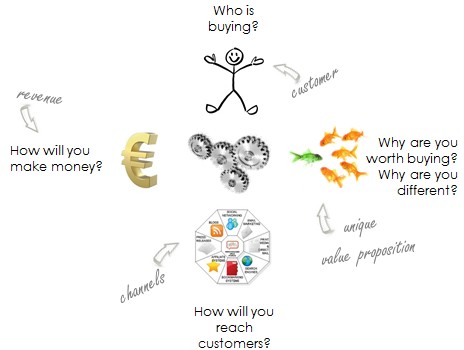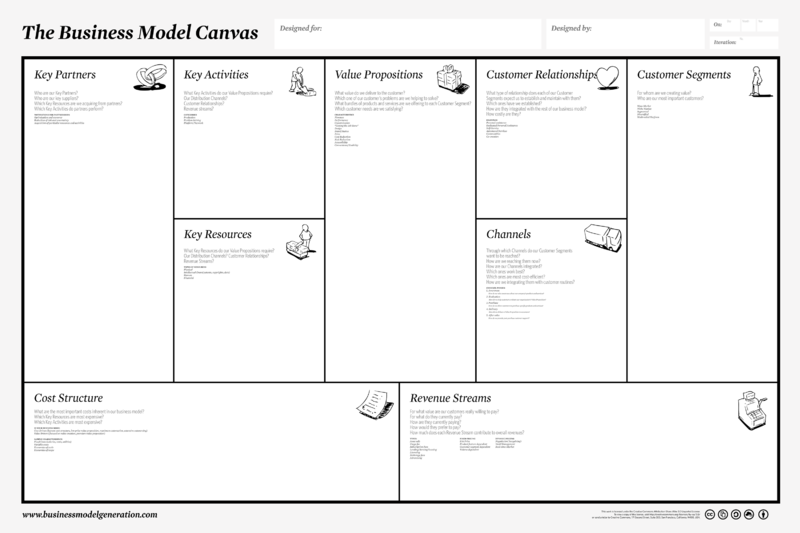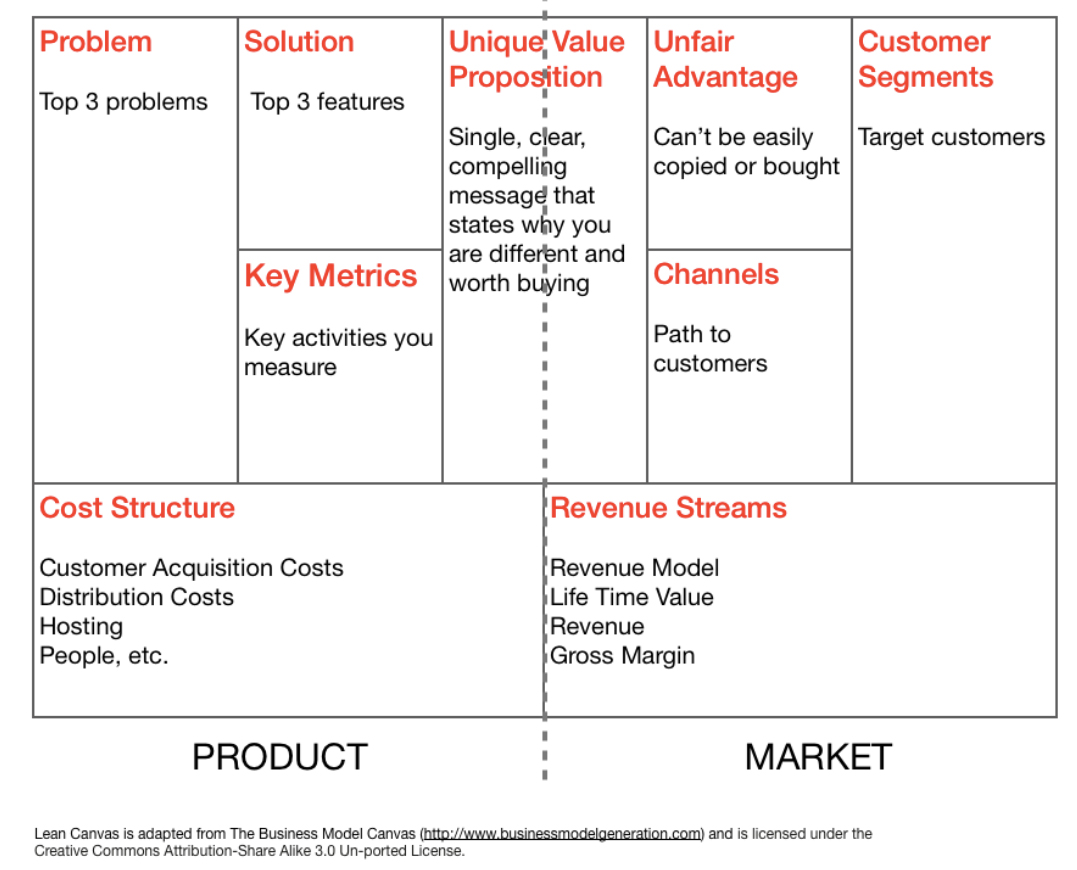What is at the heart of the scalable business you are developing? A new product or a service? Indeed, that is essential. A logical next step would be to start designing that product, right?
Just hold on for a bit more.
A scalable business is well, a business. And business is much more than the service or the product alone. There’s the customer—without him or her, there is no business. Hmm, so we’ll need the way to reach our customers. And yes, surely, at the end of the day, a business is there to make money. In fact, all of these work together, as fine mechanics of a well oiled machine.
So where should one start then? By designing a money making machine—a.k.a. a scalable business model.
There are many aspects to a business model, but these 4 are essential:
| Revenue: | How do you make money? |
| Customer: | Who pays the bill? |
| Value proposition: | How are you making their life better? Why do they buy from you and not from someone else? |
| Channels: | How do they get to know you? |
And here are 5 steps you can take next week to start designing your business model.
1. Design a Customer-Problem Fit
First, you need to think about who your likely customer really is. Be very specific. “First-time moms” or “Development managers in product companies with teams > 20 developers” is better than Internet users.
Picture your ideal customer. Try to figure out as much as you can about her. And I’m sure you know a difference between a customer and a user? Hint: look for the one with a wallet. Whether you have other kinds of users, it is the one paying the bill to whom you need to make a real difference.

List 3-5 potential (paying) customers of your service.
|

Pick one customer that is most likely to be your early adopter(*).
|
(*) Early adopter is a special kind of customer. They will want to use your product even when it’s not ready yet. Steve Blank calls them earlyvangelists, and gives you 5 characteristics you can use to spot an earlyvangelist. An earlyvangelist:
- has a problem
- understands they have a problem
- is actively searching for a solution and has a timetable for finding it
- has cobbled together an interim solution (so great is the pain)
- has, or can quickly acquire, the budget to purchase the product that solves their problem.

For inspiration, you can check out this slide deck on customer hypotheses from Steve Blank.
Now that you know who she is, you need to pick one simple way to make her life better. Are you solving a pressing problem she has, making her feel better, or helping her (business) make more money? Because, solving the right problem can make you rich.

Write a list of problems you think you can solve for your customer.
|

Pick 1-3 top problems you think are a must have, and you can solve really well.
|
2. Design a Problem-Solution Fit
Now for your favourite part – your product, the solution. The keywords here are simplicity and focus.
If you already have a working product / service or a prototype, this is a relatively easy step. Pick up to three features of your product. Pick those that most directly address your customer’s problem.
If you are just starting up with a new service, you need to find a way to describe it in clear and practical terms. Visuals are best. Draw the user interface or make a paper prototype.
In both cases, focus on the essence, that one thing that makes it a really good solution for the pain of your customer. Write a scenario, and then draw a simple cartoon-like story with your customer as the hero in the story, and how product helps them on their quest.

Pick top 1-3 product features that best solve your customer’s problem.
|

Write the scenario as described above.
|

Using PowerPoint, or just pan and paper, visualise the story.
|
This will not be a wasted effort. Later you can develop this further into an explainer video for your product website.
Now, look back again at your customer and the problem you are solving for her. How is she dealing with it today – without your product? In what way are you unique – in her eyes, in terms relevant to her – compared to the alternative solutions?

For inspiration, you can check out this slide deck on value proposition from Steve Blank.
Do more thinking. Are you asking her to drastically change the way she works or lives, or do you fit well with her current workflow? How hard will it be for her to switch from whatever she is using now to your product? Will she have to go through a steep learning curve? How soon will your product start making her life better? How are you impacting other people in her immediate environment?

List 3 difficulties your customer might experience in adopting your product.
|

Brainstorm ways to avoid or address them.
|
3. Design your Profit Model
You are designing a money making machine, remember. Now you need to figure out how will you make money.

1. Brainstorm at least 3 potential sources of revenue.
|

2. For each source, list all the steps from the first customer contact, until the money is on your account.
|

3. Score each source on: complexity(1), size(2), repeatability(3) and likelihood(4).
|

4. Pick one source.
|
- (1) Complexity: more steps (look at the card 2) = more complexity = more chance for problems. Simplicity = bliss.
- (2) Size: (amount of money you make from one customer) x (estimated amount of customers). Bigger = better.
- (3) Repeatability: is there a natural repeat business? Chance of recurring revenue? Opportunities to up-sell additional / complementary products / services / additional features?
- (4) Likelihood: how likely is it that your customer can pay for your offering?
For inspiration, check this out slide deck on revenue from Steve Blank.
Now think of the money you’ll need to spend. How much will it cost you to reach large enough numbers of customers and convince them to buy? How much will it cost to build and deliver the product? Will you have to partner up, and give away some of the money you make?

With the revenue you identified, and the cost you estimated, can you build a profitable business? You’ll get more detail on financial planning in a later lesson. A rough, “back of an envelope” calculation will suffice for now.

Do a back of the envelope calculation using your major cost and revenue assumptions
|

Now, double your cost and halve your revenue assumptions. Still profitable?
|
4. Design your Growth Engine
Your customers have to learn you exist, and then be convinced to buy from you. Getting known and closing deals is one of the most difficult challenges you will face.
The challenge is even greater if you want your business to scale.
A true exponential scaling means that it costs increasingly less to acquire any new customer. This implies some sort of virality. Virality happens when (on average) every user “infects” more than one new user with your service.
Why do you think GMail started off as “invitation only”, and still suggest you invite your e-mail correspondent not yet “infected” by their service?
Why does Apple insert that “Sent from my iPhone” message at the bottom of your e-mail?
Or why Facebook and LinkedIn keep on nudging you to invite new people to connect?
They all want you to do their marketing for them for free. Moreover, people are more likely to buy based on a recommendation from their family, friends or colleagues.
Is there any way of making your service spread virally through your customer base? A free version of the product, incentive for users to invite friends and colleagues, or share something with them?

Maybe you are in a business of teaching your users something. Whether it’s filling in tax returns or analyzing marketing results, “teaching” products assist the user in a complex process that requires lots of knowledge and experience to master. What works particularly well for this type of products is content marketing. Smart marketers know how to use valuable content and social media to build relationships with large audiences before making a pitch. They know how to make sure they hit the right person, with right message, at the right moment-and en masse.
What is cool about high quality, engaging content is that it can itself spread virally.

List out 10 topics related to your product your customers are likely searching for online.
|

Check if any of the topics fall under the “big seven“: personal finance, self-improvement, parenting, social media, business, news, and gadgets
|
But going viral is not for everyone, and it can even be dangerous if it happens too early.
Watch out with virality while you product still sucks. The bad news can spread as easy as the good one. [Dave McClure]
Not every business has the potential for viral spreading. Many businesses grow in other ways. Other ways that also scale nicely (even though strictly, the cost of acquisition doesn’t drop with each new customer).
Take for example online advertising. If the cost of getting a new customer is lower than what you can make off that customer, then scaling is easy: just increase your advertising budget. The only important thing is knowing exactly how much it costs to get a customer – and if there is enough demand. With keyword research tools and online advertising platforms, it does not take long to answer this question.
Another way to achieve greater scale is setting up affiliate programs. Instead of selling to the end customer, you reach out to people in your niche, and let them sell your product for you for a piece of the cake.
There are many other ways to get known by your customers: direct marketing, trade shows, offline media advertising, door-to-door selling…

Or check out this slide deck from Steve Blank for more inspiration.
5. Put it all Together
You are in luck. During the last couple of years, everyone seems to be talking about business models. And not just talking. A couple of very smart folks gave us practical techniques and tools to get us started.
If you haven’t heard of Osterwalder’s business model canvas, I warmly recommend you check it out. What’s cool about the canvas is that it collects 9 essential building blocks of a business on a single sheet of paper. Miss one and you got no business. The canvas can also be used as a brainstorm tool. Print the canvas on a big sheet, and brainstorm around it with your team.
Another great alternative is Lean Canvas by Ash Maurya. It is a bit simpler to use, and a slightly better fit when starting up a new business. It separates problem from the solution. This is what Ash has to say about business model design. He also provides an online lean canvas tool, allowing you to share your lean canvas with your partners or mentors.

Fill in one copy of Lean Canvas
|

Get feedback from at least 5 different people on it.
|
You may be tempted to fill in multiple customers on your sheet. Customer choice impacts the other aspects greatly, so it’s best to produce one canvas per customer segment.
Conclusion and Next Steps
Taking the time to think is important. There’s much to think about and lots you can read. But there is a caveat.
Warning: don’t get stuck in analysis paralysis.
The trick is to do just enough strategic thinking to get you started and validating, not to spend months writing a business plan that is mostly science fiction anyway.
But what can you do? That will exactly be the topic of the next lesson. Until then, get started on your business design.
Got questions? Want to share tips with others? Just comment below or mail us.



